Complete Solutions to REVIEW QUESTIONS of chapter TRANSPIRATION of Class 10 book with complete answers and questions
| Class 10 | BIOLOGY |
| Chapter | TRANSPIRATION |
| EVERGREEN PUBLICATION | REVIEW QUESTIONS |
| Number Of Questions | 100 |
| Academic Year | 2023-24 |
Name the following :
Respiratory openings found on the stem of woody plants.01:11View SolutionPotomater is used for measuring
01:28View SolutionIn which of the following plant sunken
02:47View SolutionName the following :
An apparatus to compare the rate of transpiration in a cut shoot.01:06View SolutionName the following :
Kidney shaped cells present at the borders of stomata.01:06View SolutionName the following :
Respiratory openings found on the stem of woody plants.01:11View SolutionName the following :
Loss of cell sap from the injured part of a plant.01:35View SolutionName the following :
The loss of water from injured parts of a plant.01:10View SolutionName the outermost layer of the epidermis.
03:18View SolutionGiven below are certain biological statements which are incomplete and hence incorrect. Rewrite the correct form of the statement by inserting suitable word/words at right place. Do not delete any word already given in the statement. Underline the inserted word/words.
Transpiration is the loss of water from the leaves of a plant.02:58View SolutionGiven below are certain biological statements which are incomplete and hence incorrect. Rewrite the correct form of the statement by inserting suitable word/words at right place. Do not delete any word already given in the statement. Underline the inserted word/words.
The opening and closing of stomata is controlled by guard cells.03:16View SolutionGiven below are certain biological statements which are incomplete and hence incorrect. Rewrite the correct form of the statement by inserting suitable word/words at right place. Do not delete any word already given in the statement. Underline the inserted word/words.
More transpiration occurs from the dorsiventral leaf.01:56View SolutionGiven below are certain biological statements which are incomplete and hence incorrect. Rewrite the correct form of the statement by inserting suitable word/words at right place. Do not delete any word already given in the statement. Underline the inserted word/words.
Guttation is the loss of water along the margins of leaves02:30View SolutionGiven below are certain biological statements which are incomplete and hence incorrect. Rewrite the correct form of the statement by inserting suitable word/words at right place. Do not delete any word already given in the statement. Underline the inserted word/words.
Bleeding is the exudation of sap or watery solution from the parts of a plant.02:11View SolutionState whether true or false. Rewrite the false statements in their correct form :
Rate of transpiration is directly proportional to the surface area of the leaves.02:28View SolutionState whether true or false. Rewrite the false statements in their correct form :
The plants transpire more in high humid conditions outside the plant.01:31View SolutionState whether true or false. Rewrite the false statements in their correct form :
Bleeding in plants takes place because of reduced root pressure.01:13View SolutionState whether true or false. Rewrite the false statements in their correct form :
Stomatal pores open or close in response to the turgor pressure of the guard cells.03:13View SolutionState whether true or false. Rewrite the false statements in their correct form :
Transpiration is more from the upper surface of a leaf as compared to lower surface in a dorsiventral leaf.01:27View SolutionList three external factors that increase the rate of transpiration
01:30View SolutionGive a brief account of significance of transpiration.
01:08View SolutionComment upon the following :
Plants have to pay the price of photosynthesis in the form of transpiration.01:07View SolutionComment upon the following :
Transpiration is a necessary evil.03:32View SolutionComment upon the following :
Some plants show wilting of their leaves, even when the soil is well watered.01:05View SolutionComment upon the following :
A higher rate of transpiration is recorded on windy days rather than on a calm day.02:50View SolutionComment upon the following :
During the day transpiration and photosynthesis are interlinked04:28View SolutionComment upon the following :
The leaves of plants roll up on a bright sunny day.03:20View SolutionDefine the following terms:
Transpiration02:05View SolutionDefine the following terms:
Guttation02:43View SolutionDefine the following terms:
Bleeding01:07View SolutionDefine the following terms:
Potometer01:29View SolutionDefine the following terms:
Wilting01:43View SolutionDefine the following terms:
Hydathodes01:39View SolutionDifferentiate between the following:
Transpiration and evaporation02:52View SolutionTranspiration and guttation
03:52View SolutionDifferentiate between the following:
Stomata! and Lenticular Transpiration01:27View SolutionDifferentiate between the following:
Stomata and Hydathodes.02:14View SolutionDifferentiate between:
Guttation and Bleeding02:50View Solution[A]: Wax, resin and suberin coating on the surface of plant parts reduce the rate of transpiration.
[R]: These adaptations are found mostly in xerophytes.02:49View SolutionWhat is transpiration ? Mention various kinds of transpiration.
01:25View SolutionGiven below is the diagram of an experimental set-up to study the process of transpiration in plants. Study the same and then answer the questions that follow :
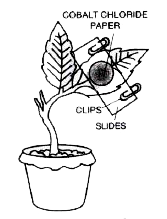
What is the colour of dry cobalt chloride paper?01:44View SolutionGiven below is the diagram of an experimental set-up to study the process of transpiration in plants. Study the same and then answer the questions that follow :
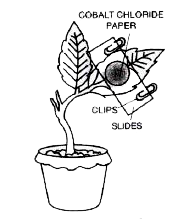
ls the experimental leaf a monocot or a dicot ? Give a reason to support your answer.03:22View SolutionGiven below is the diagram of an experimental set-up to study the process of transpiration in plants. Study the same and then answer the questions that follow :
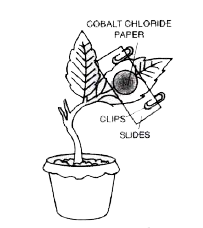
Why are glass slides placed over the dry cobalt chloride papers ?01:58View SolutionGiven below is the diagram of an experimental set-up to study the process of transpiration in plants. Study the same and then answer the questions that follow :
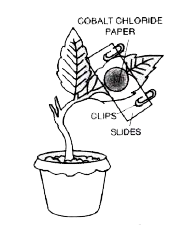
After about half an hour what change, if any, would you expect to find in the cobalt chloride papers placed on the dorsal and ventral sides of the leaf? Give a reason to support your answer.03:33View SolutionGiven below is the diagram of an experimental set-up to study the process of transpiration in plants. Study the same and then answer the questions that follow :

Define the term 'transpiration'.01:41View SolutionGiven below are sets of five terms each. In each case rewrite the terms in logical sequence as directed at the end of each statement.
Stoma, Mesophyll cells, Xylem, Substomatal space, lntercellular space (loss of water due to transpiration),01:12View SolutionWrite in a logical sequence
Cortical cells, roots hair, soil water, endodermis, xylem (entry of water into the plant from the soil).01:44View SolutionGiven below are sets of five terms each. In each case rewrite the terms in logical sequence as directed at the end of each statement.
Spongy cells, upper epidermis, stoma, palisade tissue, substomatal space.02:01View SolutionGiven below is an experimental set-up to study a particular process:
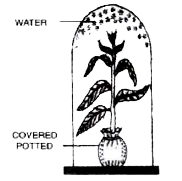
Name the process being studied.01:12View SolutionGiven below is an experimental set-up to study a particular process:

Name the process being studied.01:12View SolutionGiven below is an experimental set-up to study a particular process:
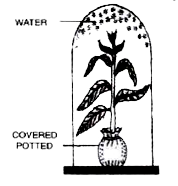
Why is the pot covered with a plastic sheet ?02:28View SolutionGiven below is an experimental set-up to study a particular process:

Mention one way in which this process is beneficial to the plant.00:56View SolutionGiven below is an experimental set-up to study a particular process:
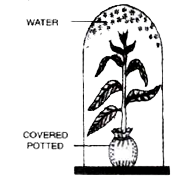
Suggest a suitable control for this experiment.01:59View SolutionGive the specific function of the following structures found in the body of plants.
Hydathodes01:27View SolutionGive the specific function of the following structures found in the body of plants/animals.
Xylem01:18View SolutionGive the specific function of the following structures found in the body of plants/animals.
Lenticels01:15View SolutionGive the specific function of the following structures found in the body of plants/animals.
Guard cells00:57View SolutionThe diagram given below represents a structure found In a leaf.

Study the same and answer the questions that follow:
Name the parts labelled A and B.01:15View SolutionThe diagram given below represents a structure found In a leaf.
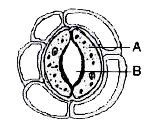
Study the same and answer the questions that follow:
What is the biological term for the above structure?01:08View SolutionThe diagram given below represents a structure found In a leaf.
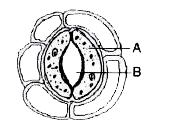
Study the same and answer the questions that follow:
What is the function of the part labelled A?01:11View SolutionThe diagram given below represents a structure found In a leaf.
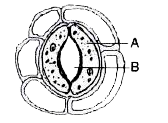
Study the same and answer the questions that follow:
Mention two structural features of A, which help in the function labelled in A above01:20View SolutionThe diagram given below represents a structure found In a leaf.
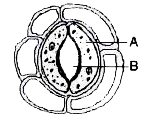
Study the same and answer the questions that follow:
Where is this structure likely to be found in a leaf?01:09View SolutionThe diagram given below represents a structure found In a leaf.
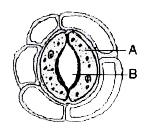
Study the same and answer the questions that follow:
The above structure helps in the process of transpiration. Explain the term transpiration.01:38View SolutionThe diagram given below represents a structure found In a leaf.
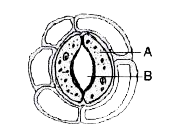
Study the same and answer the questions that follow:
How many other cells are found surrounding this structure as seen In the diagram.01:09View SolutionMention three adaptations found in plants to reduce transpiration.
01:43View SolutionExplain the term root pressure.
03:20View SolutionExplain how the rate of transpiration Is affected on :
a windy day01:34View SolutionExplain how the rate of transpiration Is affected on :
a foggy day01:43View SolutionChoose the correct answer
Loss of water as droplets from hydathodes is called:02:57View SolutionChoose the correct answer
Which one of the following does not affect the rate of transpiration ?02:14View SolutionGive the exact location of
Hydathodes.01:04View SolutionGive the exact location of
Lenticels.00:47View SolutionStudy the diagram given below and answer the questions that follow :
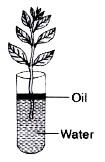
Name the process being studied in the experiment.01:32View SolutionStudy the diagram given below and answer the questions that follow :

Name the process being studied in the experiment.01:32View SolutionStudy the diagram given below and answer the questions that follow :
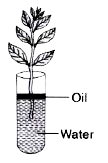
Why is oil placed over water01:10View SolutionStudy the diagram given below and answer the questions that follow :
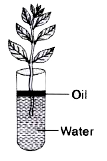
What do we observe with regard to the level of water when this set-up is placed in (1) bright sunlight (2) humid conditions (3) windy day03:28View SolutionStudy the diagram given below and answer the questions that follow :
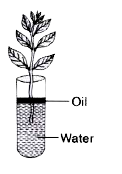
Mention any three adaptations found in plants to overcome the process studied in the experiment. .01:36View SolutionMatch the following :
 03:27View Solution
03:27View SolutionGiven below is an experimental set-up to demonstrate a particular process. Study the same and answer the questions that follow :
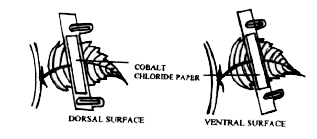
Explain the process being studied.01:18View SolutionGiven below is an experimental set-up to demonstrate a particular process. Study the same and answer the questions that follow :
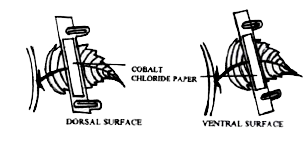
What is the aim of the above experiment ?01:39View SolutionGiven below is an experimental set-up to demonstrate a particular process. Study the same and answer the questions that follow :
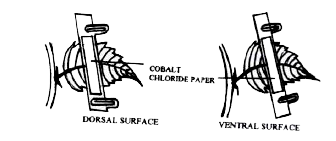
What would you observe in the experimental set up after an hour? Give a reason to support your answer.01:15View SolutionGiven below is an experimental set-up to demonstrate a particular process. Study the same and answer the questions that follow :

Mention any three adaptations found in plants to overcome the physiological process mentioned in being studied.01:12View SolutionBetween the bark and the wood in a woody stem, there is a layer of meristem called :
05:18View SolutionName the following :
An apparatus to compare the rate of transpiration in a cut shoot.01:06View SolutionFind the odd one out : transpiration, Photosynthesis, Phagocytosis and Guttation
02:43View SolutionThe figure given below represents an experimental setup with a weighing machine to demonstrate a particular process in plants. The experimental set -up was placed in bright sunlight. Study the diagram and answer the following questions :
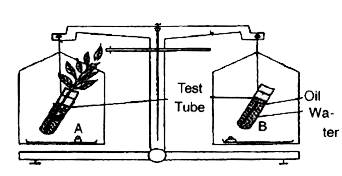
Name the process intended for study.02:16View SolutionThe figure given below represents an experimental setup with a weighing machine to demonstrate a particular process in plants. The experimental set -up was placed in bright sunlight. Study the diagram and answer the following questions :

Name the process intended for study.02:16View SolutionThe figure given below represents an experimental setup with a weighing machine to demonstrate a particular process in plants. The experimental set -up was placed in bright sunlight. Study the diagram and answer the following questions :
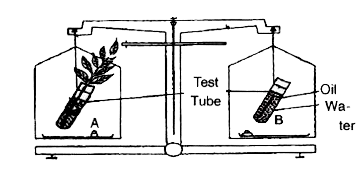
When the weight of the test tube (A & B) is taken before and after the experiment, what is observed? Give reasons to justify your observation in A & B.02:35View SolutionThe figure given below represents an experimental setup with a weighing machine to demonstrate a particular process in plants. The experimental set -up was placed in bright sunlight. Study the diagram and answer the following questions :
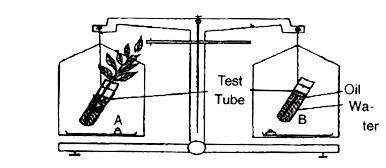
What is the purpose of keeping the test tube Bin the experimental set-up?02:47View SolutionBalsam plants wilt during midday even if the soil is well watered. Give scientific reason.
01:04View SolutionThe diagram of an apparatus given below demonstrates a particular process in plants. Study the same and answer the questions that follow :
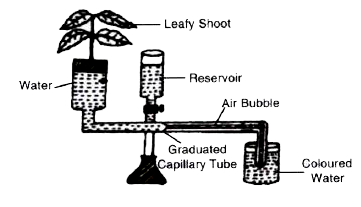
Name the apparatus.01:07View SolutionThe diagram of an apparatus given below demonstrates a particular process in plants. Study the same and answer the questions that follow :
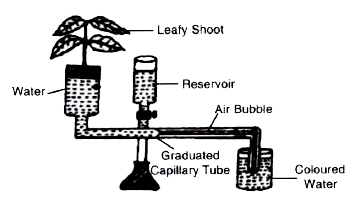
Which phenomenon is demonstrated by this apparatus?01:14View SolutionThe diagram of an apparatus given below demonstrates a particular process in plants. Study the same and answer the questions that follow :

Name the apparatus.01:07View SolutionThe diagram of an apparatus given below demonstrates a particular process in plants. Study the same and answer the questions that follow :

State two limitations of using this apparatus.01:30View SolutionThe diagram of an apparatus given below demonstrates a particular process in plants. Study the same and answer the questions that follow :
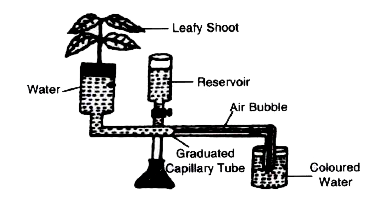
What is the importance of the air bubble in the experiment ?02:17View SolutionThe diagram of an apparatus given below demonstrates a particular process in plants. Study the same and answer the questions that follow :
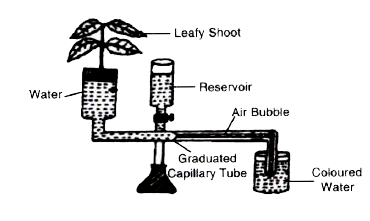
Name the structures in a plant through which the above process takes place.01:10View SolutionGive biological reason for the following statements :
In some xerophytes, leaves are modified into spines.01:04View SolutionGive biological reason for the following statements :
Plants growing in fertilized soil are often found to wilt if the soil is not adequately watered.01:13View SolutionThe diagram below represents a process in plants. The setup was placed in bright sunlight. Answer the following questions :
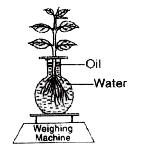
Name the physiological process depicted in the diagram .
Why was oil added to the water?01:18View SolutionThe diagram below represents a process in plants. The setup was placed in bright sunlight. Answer the following questions :
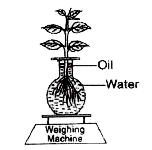
When placed in bright sunlight for four hours, what do you observe with regard to the initial and final weight of the plant?
Give a suitable reason for your answer.01:37View Solution
REVIEW QUESTIONS questions and complete solutions for chapter TRANSPIRATION of EVERGREEN BIOLOGY (ENGLISH) of Class 10
